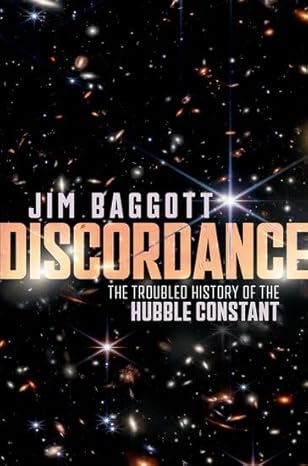Discordance: The Troubled History of the Hubble Constant
Tells the story of the Hubble constant from the earliest distance measurements to the present day. Key milestones in astronomy, astrophysics, and theoretical and observational cosmology are woven into a single narrative. Readers interested to know why scientists think they know what they know, and the current tensions that threaten to undermine the Big Bang theory completely, will find answers here.
In 1927, Georges Lemaître argued that our universe is expanding, a conclusion rendered more startling by the astronomical data that backed it up, presented two years later by Edwin Hubble. The speed of this expansion is governed by Hubble’s constant, and Discordance tells its troubled history. This begins with the first tentative steps to measure the distances to nearby stars and galaxies. It traces the extraordinary interplay between cosmological theory and astronomical observation which has given us the standard Big Bang theory. It was not all plain sailing. This is a story littered with crises of confidence, astonishing discoveries, and extraordinary personalities.
Albert Einstein regretted fudging his own equations, and dropped the ‘cosmological constant’ he had invented to make the universe stand still. The universe is expanding but appeared, absurdly, to be younger than its stars. Walter Baade found that not all stars are the same, and the Hubble constant was instantly halved. Dark matter was discovered, though we still do not know what it is. A universe born in a Big Bang should have left behind an afterglow, a window on the early universe called the cosmic background. This was found before the search for it could begin. The Hubble constant fell further, and astronomers argued intensely about its value in the ‘Hubble Wars’ of the 1970s. The theorists resolved another crisis by inventing cosmic inflation, and a new generation of satellite-based instruments was launched, amid triumph and tragedy. Observations of distant galaxies lit up by supernova explosions led to the discovery that the expansion of the universe is accelerating. Embarrassed theorists had to put back Einstein’s cosmological constant. Dark matter was joined by an equally obscure dark energy, and the visible universe was relegated to just 5% of everything there is, or would seem to be.
Further satellite missions were expected to bring together the early-universe predictions for the Hubble constant and late-universe measurements based on distances. But from about 2009 onwards, the results began to diverge. This is the Hubble tension. It is not yet clear if this is another crisis. The story is not over yet.
- Oxford University Press (23 October 2025)
- Translations: Complex Chinese, Simplified Chinese, Italian

